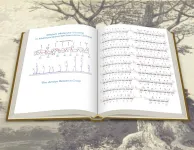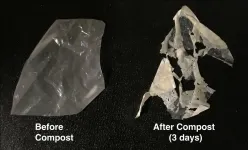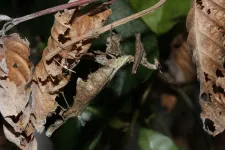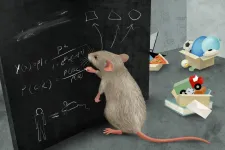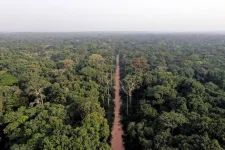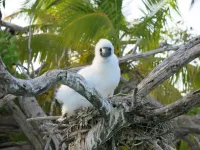INFORMATION:
Researchers share strategies for making geosciences more inclusive
2021-04-21
(Press-News.org) Concrete efforts to bring racial equity to the geosciences are receiving significant attention in the wake of new grassroots efforts and increased awareness of social justice issues in 2020, speakers said at the Seismological Society of America (SSA)'s 2021 Annual Meeting.
Last year's Black in Geoscience Week, for instance, began as a grassroots movement to increase representation and raise visibility among Black researchers, as well as to foster networks and connections across the world, said Louisa Brotherson, a leader of the Black in Geoscience group.
The need for community and awareness among Black geoscientists is critical, Brotherson said, especially in the face of severe underrepresentation in the field. In the United States, only 6% of geoscience doctoral degrees are awarded to students from underrepresented minorities, even as individuals in these groups make up 31% of the population. In the United Kingdom, Black students represent 1.6% of geology postgraduate researchers, compared to 3.8% of the 18 to 24 year-old-population in the country.
Brotherson, an experimental seismologist at the University of Liverpool, and her colleagues helped organize a variety of events for the week, held 6-12 September 2020, on social media channels and live on Zoom and YouTube. Each day focused on a different group within the geosciences broadly, including atmospheric and marine scientists, as well as the experiences of the global diaspora of Black scientists.
The week drew over 6.1 million Twitter impressions and a 3.2% engagement rate with tweets, and feedback was "overwhelmingly positive," Brotherson said. "And we are hoping that it has started longer-term changes in attitudes and further discussions."
The Black in Geoscience group is supporting new awareness campaigns and symposia by Black marine scientists and geographers, and hopes to reach out to black geoscientists working in industry as well.
Acknowledging the colonial roots of geoscience and encouraging more equal international research collaborations are among the "next big steps," Brotherson said.
"If you're planning on doing fieldwork, look for the local scientists who are already doing the work and get them on your papers," she urged. "Don't think of them as a sort of side note."
Brotherson said the week has generated essential discussions within her own university department. "It got them to re-think the way that they go about things and the way that they think about race in academia," she said, "and just being more empathetic about the people who are already there and what we can we do for people coming up."
At the SSA meeting, physicist Ben Fernando discussed how to identify barriers to inclusion and retention of underrepresented minorities in the geosciences based on a report he and others complied for his own Department of Earth Sciences at the University of Oxford.
The report offers specific recommendations to improve student and staff recruitment, inclusion, retention and academic experiences, with timelines and priorities attached to each recommendation.
The report brought to light "something that I think is quite difficult to talk about when there are so few people in the discipline to begin with, the importance of familial and cultural context," Fernando said.
For instance, "rather than think people from minority backgrounds don't hang out in the countryside and therefore don't go into the geosciences, we found some more fundamental reasons like the strained relationships that some of these communities have had with extractive industries in the past," he said.
One of the unexpected impacts of the report, Fernando said, is that its recommendations have been "helpful in making the department more pleasant for everyone."
Fernando cited the report's discussion of alcohol culture in the department, which tends to exclude those who do not drink for religious or cultural reasons. "There were older researchers, from what we might call more traditional backgrounds, who were like, 'actually, you know what, I think this is a problem too,'" he said, "and they would never have been able to say that if there hadn't been a forum where we were talking about it already."
The faculty has been supportive of the report recommendations, even though "by the head of the department's own admission, it was an uncomfortable experience for them at first, being faced with a list of more things we wanted them to do," Fernando said.
"The reason I think it's worked is that there was a list of suggestions, we clearly thought about how much time and effort they were going to take, and we told them specifically what they needed to do," he added.
ELSE PRESS RELEASES FROM THIS DATE:
Pepper the robot talks to itself to improve its interactions with people
2021-04-21
Ever wondered why your virtual home assistant doesn't understand your questions? Or why your navigation app took you on the side street instead of the highway? In a study published April 21st in the journal iScience, Italian researchers designed a robot that "thinks out loud" so that users can hear its thought process and better understand the robot's motivations and decisions.
"If you were able to hear what the robots are thinking, then the robot might be more trustworthy," says co-author Antonio Chella, describing first author Arianna Pipitone's idea that launched the study at the University of Palermo. "The robots will be easier to understand for ...
Jane Austen quote encoded in a polymer
2021-04-21
Using a novel molecular-data-storage technique, researchers at the University of Texas at Austin have encoded a quote from Jane Austen's classic novel Mansfield Park in a series of oligomers, which a third party could read back without prior knowledge of the structures that encoded the passage. The findings, published April 21st in the journal Cell Reports Physical Science, illustrate a method to encode data that allows for greater information density than DNA-based approaches and that relies on urethane-like plastics--highly accessible and structurally modifiable chemical feedstocks--instead of nucleic acids.
"This work is another step toward the long-term goal of using synthetic sequence-defined polymers for information storage," says Eric Anslyn, a chemistry ...
New process makes 'biodegradable' plastics truly compostable
2021-04-21
Biodegradable plastics have been advertised as one solution to the plastic pollution problem bedeviling the world, but today's "compostable" plastic bags, utensils and cup lids don't break down during typical composting and contaminate other recyclable plastics, creating headaches for recyclers. Most compostable plastics, made primarily of the polyester known as polylactic acid, or PLA, end up in landfills and last as long as forever plastics.
University of California, Berkeley, scientists have now invented a way to make these compostable plastics break down more easily, with just heat and water, within a few weeks, solving a problem that has flummoxed the plastics industry and environmentalists.
"People are now prepared to move into biodegradable polymers for single-use ...
Dating in a jungle: Female praying mantises jut out weird pheromone gland to attract mates
2021-04-21
It isn't only myriads of currently unknown species that await discovery in the Amazon rainforests. As a new study by German scientists at the Ruhr-University (Bochum) and the Bavarian State Collection of Zoology (Munich), published in the open-access peer-reviewed scientific Journal of Orthoptera Research, concludes, it seems that so do plenty of unusual behaviours.
"When I saw the maggot-like structures peeking out from the back of the praying mantis and then withdrew, I immediately thought of parasites that eat the animal from the inside, because that is not really uncommon in insects," says Frank Glaw, a reptile and amphibian expert from the Bavarian State Collection of Zoology, who discovered ...
Simplifying our world
2021-04-21
Categorization is the brain's tool to organize nearly everything we encounter in our daily lives. Grouping information into categories simplifies our complex world and helps us to react quickly and effectively to new experiences. Scientists at the Max Planck Institute of Neurobiology have now shown that also mice categorize surprisingly well. The researchers identified neurons encoding learned categories and thereby demonstrated how abstract information is represented at the neuronal level.
A toddler is looking at a new picture book. Suddenly it points to an illustration and shouts 'chair'. The kid made the right call, but that does not seem particularly noteworthy to us. We recognize all kinds of chairs as 'chair' without any difficulty. ...
Central African forests are unequally vulnerable to global change
2021-04-21
Central Africa is home to the world's second-largest area of dense tropical rainforest. This major reservoir of biodiversity stretches out over five main countries: Cameroon, Gabon, the Republic of Congo, the Democratic Republic of Congo and the Central African Republic. It provides numerous ecosystem services, such as regulating exchange cycles between the earth and the atmosphere, and helps to ensure food supply for local populations. Due to the threats from climate change and demographic pressure expected in Africa by the end of the 21st century, the protection and sustainable management of these forests is a challenge for policy ...
Climate 'tipping points' need not be the end of the world
2021-04-21
The disastrous consequences of climate "tipping points" could be averted if global warming was reversed quickly enough, new research suggests.
Once triggered, tipping points may lead to abrupt changes such as the dieback of the Amazon rainforest or melting of major ice sheets.
Until now, crossing these thresholds has been assumed to be a point of no return, but the new study - published in the journal Nature - concludes that thresholds could be "temporarily exceeded" without prompting permanent shifts.
The research team, from the University of Exeter and the UK Centre for Ecology and Hydrology (UKCEH), say the time available to act would depend on the level ...
New evidence shows important seabird nutrients reach coral reefs after rat eradication
2021-04-21
Scientists have provided the first evidence to show that eradicating rats from tropical islands effects not just the biodiversity on the islands, but also the fragile coral seas that surround them.
The new study led by scientists at Lancaster University and published in the journal Current Biology shows that critical cycles of seabird nutrients flowing to coral reefs are re-established within relatively short time periods after rats are removed - even around islands that have been infested for hundreds of years.
The findings offer encouragement that rat eradication can benefit coral ...
Examining association between wildfire air pollution, clinic visits for Eczema, itch
2021-04-21
What The Study Did: Researchers looked at whether short-term exposure to air pollution from a 2018 California wildfire was associated with changes in the number of clinic visits for eczema or itch and medications prescribed for eczema.
Authors: Maria L. Wei, M.D., Ph.D., of the University of California, San Francisco, is the corresponding author.
To access the embargoed study: Visit our For The Media website at this link https://media.jamanetwork.com/
(doi:10.1001/jamadermatol.2021.0179)
Editor's Note: The article includes conflicts of interest and funding/support disclosures. Please see the article for additional information, including other authors, author contributions and affiliations, conflict of interest and financial disclosures, ...
First of its kind study links wildfire smoke to skin disease
2021-04-21
Wildfire smoke can trigger a host of respiratory and cardiovascular symptoms, ranging from runny nose and cough to a potentially life-threatening heart attack or stroke. A new study suggests that the dangers posed by wildfire smoke may also extend to the largest organ in the human body, and our first line of defense against outside threat: the skin.
During the two weeks in November 2018 when wildfire smoke from the Camp Fire choked the San Francisco Bay Area, health clinics in San Francisco saw an uptick in the number of patients visiting with concerns of eczema, also known as atopic dermatitis, and general itch, compared to the same time of the year ...
